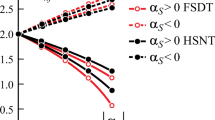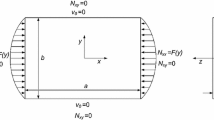Abstract
A global higher-order shear deformation theory is devised to obtain the governing equations of composite plates under dynamic excitation. The time-harmonic solution leads to an eigenvalue problem for the natural frequencies of plates. The eigenvalue problem for rectangular plates is converted to a set of homogenous algebraic equations using differential quadrature method. The formulation of the problem allows direct application of various boundary conditions. Therefore, rectangular plates with mixed boundary conditions are also considered. To show the validity of results, the fundamental natural frequencies of composite plates with different boundary conditions and those of isotropic plates with mixed boundary conditions are compared against the results available in the literature.
Similar content being viewed by others
References
Nguyen-Van H., Mai-Duy N., Tran-Cong T.: Free vibration analysis of laminated plate/shell structures based on FSDT with a stabilized nodal-integrated quadrilateral element. J. Sound Vib. 313, 205–223 (2008)
Civalek O.: Free vibration analysis of symmetrically laminated composite plates with first-order shear deformation theory (FSDT) by discrete convolution method. Finite Elem. Anal. Des. 44(12–13), 725–731 (2008)
Bhimaraddi A., Stevens L.K.: A high-order theory for free vibration of orthotropic, homogeneous, and laminated rectangular plates. J. Appl. Mech. 51, 195–198 (1984)
Reddy J.N., Phan N.D.: Stability and vibration of isotropic, orthotropic and laminated plates according to a higher order shear-deformation theory. J. Sound Vib. 98, 157–170 (1985)
Khdeir A., Reddy J.N.: Free vibrations of laminated composite plates using second-order shear deformation theory. Comput. Struct. 71, 617–626 (1999)
Matsunaga H.: Vibration and stability of cross-ply laminated composite plates according to a global higher-order plate theory. Compos. Struct. 48, 231–244 (2000)
Kant T., Swaminatha K.: Analytical solutions for free vibration of laminated composite and sandwich plates based on a higher-order refined theory. Compos. Struct. 53, 73–85 (2001)
Messina A.: Two generalized higher order theories in free vibration studies of multilayered plates. J. Sound Vib. 242, 125–150 (2001)
Akhras G., Li W.: Static and free vibration analysis of composite plates using spline finite strips with higher-order shear deformation. Compos. Part B Eng. 36, 496–503 (2005)
Xiaohui R., Wanji C., Zhen W.: A new zig-zag theory and C 0plate bending element for composite and Sandwich plates. Arch. Appl. Mech. 81(2), 185–197 (2011)
Reddy J.N.: A simple higher-order theory for laminated composite plates. J. Appl. Mech. 51, 745–752 (1984)
Shu C., Wang C.M.: Treatment of mixed and non-uniform boundary conditions in GDQ vibration analysis of rectangular plates. Eng. Struct. 21, 125–134 (1999)
Yaghoubshahi M., Asadi E., Fariborz S.J.: A higher-order shell model applied to shells with mixed boundary conditions. Proc. Inst. Mech. Eng. Part C: J. Mech. Eng. Sci. 225(2), 292–303 (2011)
Wei G.W., Zhao Y.B., Xiang Y.: The determination of natural frequency of rectangular plates with mixed boundary conditions by discrete singular convolution. Int. J. Mech. Sci. 43, 1731–1746 (2001)
Lanhe W., Hua L., Daobin W.: Vibration analysis of generally laminated composite plates by the moving least squares differential quadrature method. Compos. Struct. 68, 319–330 (2005)
Author information
Authors and Affiliations
Corresponding author
Rights and permissions
About this article
Cite this article
Asadi, E., Fariborz, S.J. Free vibration of composite plates with mixed boundary conditions based on higher-order shear deformation theory. Arch Appl Mech 82, 755–766 (2012). https://doi.org/10.1007/s00419-011-0588-y
Received:
Accepted:
Published:
Issue Date:
DOI: https://doi.org/10.1007/s00419-011-0588-y




